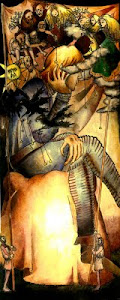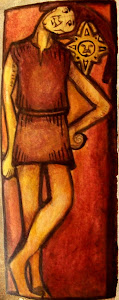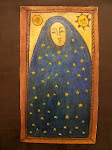
Genealogy. Mysterious but fascinating. I find myself quite interested to them. I just like how generations pass as history moves on, and also how this epic story goes by. Sometimes, they produce bizarre stories that are very good to hear and to tell.
I had been looking for some prominent houses and dynasties many times. As you can see on the left, I found detail of a late medieval painting (or is it a tapestry?) in the internet about Austrian ladies in a family tree. It was made at about 1490, and it has beautiful, jewel-like colors. Although these kinds of family tree chart are quite hard to observe and trace, they are fun to look at because I find them nice in their over decorated manner ( Yep! I have a little bit horror vaccui).
My bunny lent me a book about the royal houses and dynasties in Europe. The book entitled
Heraldry of the Royal Families of Europe by Jiri Louda and Micheal Maclagan. Her older brother John gave this to her as a birthday gift. The book contains precise charts, as what they told, of family trees. The book includes individual heralds, but is not of that good a printing, though it manages a considerable information about the houses and their realms. What I found much interesting there is about the relationships between the dynasties in Europe. It says that probably the Queens of England are very distant kinswomen of the Hashemite Kings of Jordan. But maybe this kind of story is not new since houses in Europe intermarried each other, reaching even in the east such as the Spanish kings and the Moors, through their sons and daughters.
As I read it further, it inspires me and had given me some concrete ideas for my stories such as the Annals. I have been writing about imaginary kingdoms and countries with families warring and intermarrying with each other.
I also charted my parent's family tree, from my mother back to my great grand parents. Since I mentioned my mother's family, let me tell their little stories to you. Years ago, before the First World War, there was a man named Eulogio. He had three siblings, Caridad, Rosario, and a man called "Doleng (Cross-eyed)." Eulogio was the oldest of the four children. Years later, he met a woman named Mercedes, the youngest among her five siblings: Emerenciana, the oldest, Catalina, Felipe, Teodora, and Carmela. Just like other lovers during that time, they got married as soon as possible and had twelve children. Adelina was the oldest, next was Concordia, Ortencia, Corazon, Elena, Aurea, Lucia, Rosalinda, Aniceto, Jose, Antonio, and the youngest as well as my mother, Angela. Funny enough, whenever my mother and her eldest sister are together, you could mistake them as mother and daughter. My aunt Adelina's age gap from my mother spans about three decades.
As of now, I don't have the complete data about my family. I only know the surnames of my great grand parents. Perhaps I should visit my aunt on my mother's hometown in Tarlac to get more information and old pictures. I also roughly charted my father's family tree way back also to my great grand father, named Carlos. My father said that Carlos was a really tall man, with a pale complexion and a thin body. My father saw him before, though he never met him personally. Carlos had fifteen children, and he married twice because his first wife died early.
My bunny told me that her uncle Herman also drafting their paternal family tree. What's interesting there is that he also researched the dates of their birth and death. He even researched their occupation, some old pictures, and some highlights of their story. She promised me to give me a copy of them by the time she gets hers from her uncle. I had thought of making a family tree similar to the one above.
 It was named after the red angel flying around the evening sky to attach the jewel-like stars so that the villagers have lights in the evening. It wants to make the people happy so it does the best to do this.
It was named after the red angel flying around the evening sky to attach the jewel-like stars so that the villagers have lights in the evening. It wants to make the people happy so it does the best to do this.

























































